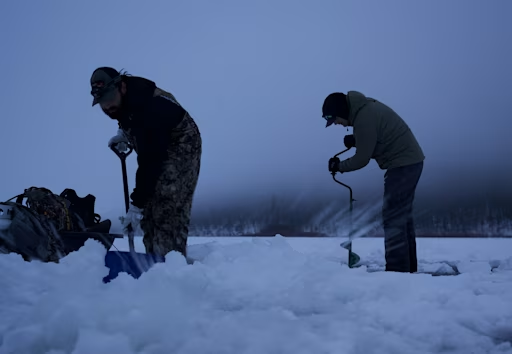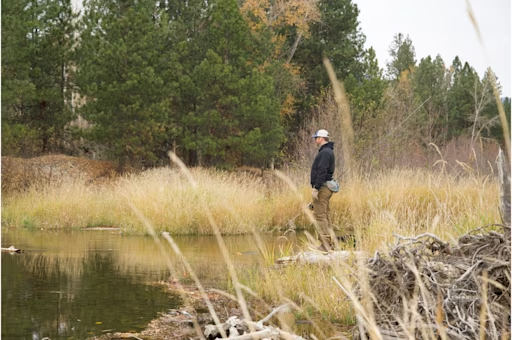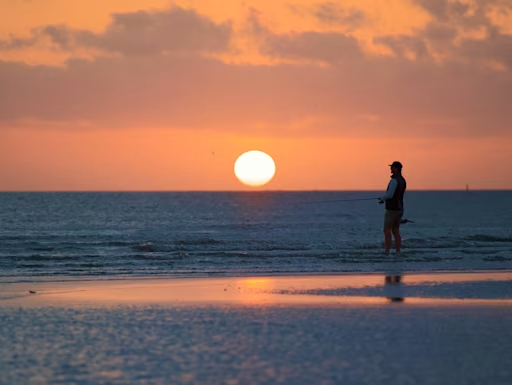Choosing the best fishing line
Having trouble selecting the best fishing line for your needs? Perhaps you keep losing your catch due to incorrect line choices. Learn more about the best fishing line for your fishing needs.
Share this article

Choosing Fishing Line: The most overlooked thing on the Hook
This article was written by one of our users, and Pro Staff, Anthony Williams.
Quickly see which fishing bait and gear is used in your local area to catch the most fish. Sign-up for your free Fishbrain account today to get started.
Why Choosing the Most Appropriate Fishing Line is Key
I often find random bits and things people have left behind when I fish, but the most common shaking-my-head worthy thing has to be the discarded rigs, jigs and line that ties them all together.
While bank fishing with my son the other day I found the all-time strangest rig pictured below, hanging from a dead branch that would have disintegrated if the wind blew hard, tied on with red 20+ lb. Monofilament. The Jig was trailerless, the Tube was rigged wrong on an EWG 2/0 hook and the small Crappie Jig was bare as I was on the day I was born. It looked like someone had put on a blindfold, went into Walmart and just grabbed the first few lures their hand touched. All three lures were tied together on the same line with overhand knots, besides the terminal knot on the Tube which was a bad clinch knot and thrown into the water as a trap-line.
This was obviously someones first attempt at fishing/trapping (I hoped) and it left me wondering why they didn’t just look up a tutorial online. It also made me mad, although it had a very low chance of catching fish, over some time, I knew eventually the tube would probably be eaten by a fish and the fish killed when it got stuck on the trap.
Many people that have been fishing longer than I have, still use the wrong line and knots when fishing even after I have suggested plenty of times, to their annoyance that they not do that.
So why is it that we neglect to learn about line? I think for too many people, including myself, it is one of the more boring parts of fishing when compared to new and exciting lures, reels, rods, and tools. Especially when it comes to catching fish. The truth of it is that line affects our fishing success more than any other part of our gear, just how many fish we catch.
First, I would like to debunk a couple of popular myths surrounding fishing line
Top Fishing Line Myths!
Fishing Line Myth #1:
Fish can’t see red. Red line is invisible.
Many people I talk to swear that Bass, Catfish and many other species that I fish for, cannot see the color red. Therefore, they reason red line is invisible! This reasoning is flawed. Wouldn’t companies have ceased making red/invisible lures by now? Even if they didn’t have red cones or rods in their eyes, it wouldn’t make the line disappear, it would just default to another color.
I believe this myth comes from semi-recent findings that many deep-water fish are red because deep/dark water filters red, which has the longest wavelength of visible light out of the spectrum first, rendering them the same color as their background. Anyways… you can do your own research but I’m calling this one debunked. Stick with clear, small, Fluorocarbon line if you don’t want the fish to see it.
Fishing Line Myth #2:
Braid catches just as many fish as small Mono/Fluoro
Bass and other Gamefish are just dumb animals and a tiny bit of difference in line diameter isn’t going to matter. They’ll hit anything that moves, right? Wrong!
I can’t count the number of times that I have had my 50-65 lb. Braid fall slack on a long cast, zig-zagging its way back to me on top of the water and then had a Bass either spook from seeing it, or actually smack my line thinking that it was prey. I won’t say that this doesn’t ever happen with a smaller diameter line, but it happens very infrequently. When finesse fishing, stick with small line unless you’re in the thick of it.
A sub-division of this myth is that fish can’t tell the difference in the line we use.
While this may be partially true for some species like Catfish, when it comes to Bass and active Gamefish, they may not always see the difference in line, but they can often feel it. Again, when fishing with braid, I would notice that finicky Bass would often spook before my lure got anywhere close to them. This puzzled me for a long time until I realized that the line is coming through the area that they are in long before they even have sight of the lure. Braid transmits vibration so much better than Monofilament and especially Fluorocarbon. So… the fish may not see this, but they can definitely feel it.
Now let’s get down to the real lines of this Article. What type of line is good for what and what type of line matches the rod. Always be sure to check the line recommendations on your rod as a starting point too. I try to stay as low on that spectrum as I can without worrying that I will break off.
Tips for Choosing Fishing Line
Did you know you can use the Fishbrain app to see popular gear near you? Quickly see what gear your local anglers are using to catch the most fish with a free Fishbrain account.
Braided Line:
Now that I have dissed braid so badly, let me tell you the truth: I love braided line. I probably use it a lot more than the average advanced angler does and I believe that it is the reason that I have landed, rather than lost the three biggest Bass I have ever caught. Because I can’t afford to go pro and I am very close to broke most of the time, I spool almost all of my reels with braided line and tie a 1 to 6-foot leader of Fluoro or Monoline with an FG knot (highly recommended knot to learn). Braid lasts for months if you treat it right and even the light stuff I.e., 10 lb. is much harder to break off with than the 10 lb. Versions of Fluoro or Mono. It will save you hundreds of dollars on line if you are on a budget. It works amazing as stand-alone top-water lure line too if you use a moderate or slow rod instead of a faster rod with mono. Although, I prefer expensive 8 carrier braided line, I always end up getting the plain old Power Pro Braid I have reels that have had this stuff on the spool for two years, literally ‘til it gets too short to cast with and it still has all four carriers (individual fibers) intact. You just can’t beat this stuff for the price. If you have the money though, go with the Power Pro 8 carrier Super Slick or even the top-rated Spider Wire. I like the darker green colors exclusively for Bass fishing.
Braided Line Recommendations:



Spider Wire, Moss Green
Monofilament:
The original fishing line. This stuff has been around since the 1950’s. This would have to be my least favorite line (although I know all three have their places and I sound like an amateur saying this), but it is the least-costly and most commonly used line. The only time I use mono is for topwater dog-walking applications. It is stretchier than Fluorocarbon and doesn’t sink and get caught under the first treble like Braid or Fluoro when used with dog-walked lures like a spook. Many pro’s would scoff at me for this and I may learn my lesson one day… but today is not that day. It can also be used when you want to keep a crankbait higher than its rating in the water column. I use the Sufix Elite. It’s cheap price-wise but quality stuff and it doesn’t get kinked up or birds-nested really easily like some mono does.
Monofilament Line Recommendations

Fluorocarbon:
Fluorocarbon is possibly the most versatile of all three common lines in fishing. It can be used for every application including topwater and although many people would argue against this, I like having a softer/slower rod paired with a stiffer line rather than a stretchier line paired with a stiffer rod. There are many reasons for this, personally, but practically it’s because Fluorocarbon is much tougher, smaller, and therefore much less visible/palpable to the fish than Monofilament or Braid.
Fluorocarbon also sinks in water and smaller diameter line sinks faster which means that you can get lures deeper, quicker when power fishing as well. I prefer Sunline Sniper if I have the extra dough, but the toughest stuff I use is the regular old Seaguar. Fluorocarbon is practically invisible in the water anyways but if you’re serious about stealth go with the Seaguar InvisX which feels and moves like silk in the lower test lbs.
All three lines have other merits that I didn’t mention here, but also have entire articles devoted to each out there.
Fluorocarbon Line Recommendations

Seaguar Florocarbon
Pairing:
The most important part of the article is to pair your lines properly. One tip is to test on a catfish combo. The line that goes on your rod is literally written (unless it’s a cheap one) on the rod. Although you can supersede this, I wouldn’t recommend going under the limit.
The thicker/heavier the lure/hook, the thicker/heavier the rod, the thicker the line. It’s so easy!
Line Tips for Finesse Applications
For Finesse applications (light, slowly worked lures), start at 10 lb. Test if the water is badly stained and depending on clarity, work your way down to 4 lb. If the water is clear to 10 feet and the fish are spooky.
Line Tips for Power Applications
For Power applications (fast retrieval and casting) start at 10 lb. Test if the water is clear and work your way up to 20 lb. line if the water is stained. In muddy water I stop worrying about whether or not to use braid and go with it almost exclusively.
Line Tips for Hybrid Applications
For Hybrid applications like Skirted Jigs or Spinnerbaits/Chatterbaits, use this rule of thumb - the thicker/bigger the hook, the higher up the test lb. you should go on the rod and line. With a 4/0+ gauge heavy-wire hook or higher, you need at least 12 lb. Test. If you are getting up to 5/0 and 6/0 heavy or ultra-heavy you’re going to want 15-20 lb. test fluorocarbon until you get really good at it.
Other Resources
There are a few more things to cover in other blog posts. One is knot tying, which we have a great resource on How to Tie Fishing Knots. We also have some excellent beginner's guides: How to choose fishing gear and How to choose fishing lures which will help you out.
Join the Fishbrain community and learn about fishing gear, find local fishing spots, chat with anglers and more.

Download the Fishbrain app and access the best fishing spots in your area
Related blog posts
Master the hardwater season with advanced ice fishing tips . Learn how to find fish faster, refine your search and adjust presentations to catch more fish all winter long.

Your guide to Victoria’s best fish to catch in rivers, lakes, and coastal waters. Learn prime species, fishing tips, and key regulations

Learn how fish adapt as water temperatures cool from autumn to winter, including changes in behavior, metabolism, and habitat that help them survive.




